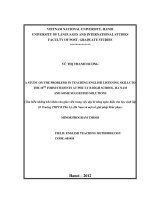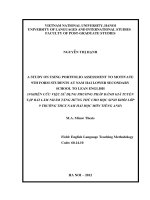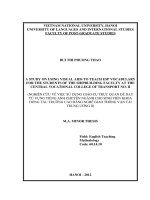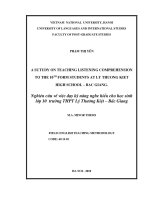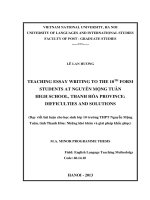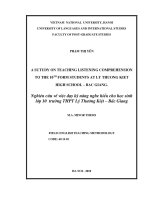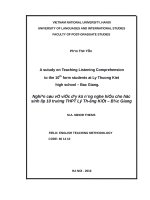A study on using visual aids to teach grammar to the 10th form students at nghi loc III high school
Bạn đang xem bản rút gọn của tài liệu. Xem và tải ngay bản đầy đủ của tài liệu tại đây (1.61 MB, 87 trang )
vinh university
foreign Languages department
=== ===
bïi yÕn nhi
A Study on using Visual Aids to teach
Grammar to the 10 th form students
at Nghi Loc III high school
(nghiªn cøu vỊ việc sử dụng giáo cụ trực quan
trong việc dạy ngữ ph¸p cho häc sinh líp 10
ë trêng
trêng thpt nghi léc III)
graduation thesis
Field: English Teaching Methodology
Vinh - 2011
vinh university
foreign Languages department
=== ===
A Study on using Visual Aids to teach
Grammar to the 10 th form students
at Nghi Loc III high school
(nghiªn cøu vỊ viƯc sư dụng giáo cụ trực quan
trong việc dạy ngữ pháp cho häc sinh líp 10
ë trêng
trêng thpt nghi léc III)
graduation thesis
Field: English Teaching Methodology
Supervisor:
bïi thÞ thanh mai, m.a
Student:
bïi yÕn nhi, 48A - English
Vinh - 2011
A Study on using Visual Aids to teach Grammar to the 10th form students
at Nghi Loc III high school
ACKOWLEDGEMENTS
For the completion of this work, I have been fortunate to receive the
great help and useful advice from my teachers, my family as well as my friends
First of all, I would like to express my profound gratitude and
indebtedness to my supervisor - M.A Bui Thi Thanh Mai, who during the
course of my writing has always been most willing to give enthusiastic
instruction, excellent suggestions, expert advices, as well as to discuss with
me the usefulness and validity of various sections of this work.
Furthermore, I also wish to convey my sincere thanks to the teachers of
Foreign Language Department, Vinh University and my classmates for their
suggestions, discussion and advices on the further reading in this area.
Last but not least, my sincere appreciation and thanks go to my family,
my teachers and students at Nghi Loc III high school for their kind help and
great contribution to my survey.
Vinh, May 10, 2011
Bui Yen Nhi
Bùi Yến Nhi - 48A English
i
Foreign Languages Department
A Study on using Visual Aids to teach Grammar to the 10th form students
at Nghi Loc III high school
ABSTRACT
Nowadays, in Vietnam, English is used more and more widely by both
the young and the old. Therefore, the teaching and learning of English have
become more significant.
In any languages, grammar is considered one of the most essential
elements of language. We can hardly comprehend the meaning exactly if we
do not use grammar appropriately. So poor knowledge of English grammar
can effect both the learning and teaching of English.
This thesis has been written with the intention of recording my
students’ and my own reflections on and reaction to the theme Visual Aids in
Teaching and Learning Grammar during the course. To know about the useful
of visual aids in teaching grammar, this graduation paper limits itself to “A
Study on using Visual Aids to teach Grammar to the tenth form students at
Nghi Loc III high school”.
Based on theoretical and practical findings, some kinds of visual aids
and their use in teaching grammar will be introduced. The study suggests one
of the most effective and interesting ways in presenting, practicing and
producing a grammatical structure.
It is hoped that this study may be useful for those who are seeking the
teaching methods, which are aimed at improving the current English learning
and teaching.
Bùi Yến Nhi - 48A English
ii
Foreign Languages Department
A Study on using Visual Aids to teach Grammar to the 10th form students
at Nghi Loc III high school
TABLE OF CONTENTS
Page
ACKOWLEDGEMENTS................................................................................i
ABSTRACT.....................................................................................................ii
TABLE OF CONTENTS...............................................................................iii
LIST OF TABLES AND FIGURES.............................................................vi
LIST OF ABBREVIATIONS.......................................................................vii
PART I. INTRODUCTION............................................................................1
1.
Justification of the Study........................................................................1
2.
Aims and Objectives of the Study..........................................................2
3.
Method of the Study...............................................................................2
4.
Scope of the Study..................................................................................3
5.
Design of the Study................................................................................3
PART II. INVESTIGATION..........................................................................5
CHAPTER 1: THEORETICAL BACKGROUND......................................5
1.1.
GRAMMAR...........................................................................................5
1.1.1. Definition of grammar............................................................................5
1.1.2. Grammatical Structures..........................................................................6
1.1.3. View on Grammar Teaching..................................................................7
1.1.4. What need to be taught?.........................................................................8
1.1.5. Principles for Teaching Grammar..........................................................9
1.1.6. Procedures for Teaching a New Structure............................................11
1.2.
VISUAL AIDS.....................................................................................11
1.2.1. Definition..............................................................................................11
1.2.2. Roles of Visual Aids in language teaching...........................................11
1.2.3. Roles of using Visual Aids in teaching grammar.................................14
Bùi Yến Nhi - 48A English
iii
Foreign Languages Department
A Study on using Visual Aids to teach Grammar to the 10th form students
at Nghi Loc III high school
1.2.4. Types of Visual Aids............................................................................15
1.2.5. Criteria for choosing or making Visual Aids........................................26
1.2.6. Conclusion............................................................................................27
CHAPTER 2: DATA ANALYSIS................................................................28
2.1.
INTRODUCTION OF THE SUBJECTS.............................................28
2.1.1. Students, their background and learning conditions.............................28
2.1.2. Teachers and their working condition..................................................29
2.2.
THE
PURPOSE
AND
THE
CONTENT
OF
THE
QUESTIONNAIRES..........................................................................29
2.2.1. The purpose of questionnaires..............................................................29
2.2.2. The content of questionnaires...............................................................29
2.3.
DATA ANALYSIS..............................................................................30
2.3.1. Analysis of the data collected from students........................................30
3.3.2. Analysis of the data collected from the teachers..................................34
2.3.3. Findings................................................................................................37
CHAPTER 3: TEACHING APPLICATION..............................................39
3.1.
AT THE PRESENTATION STAGE....................................................39
3.1.1. Using the board.....................................................................................39
3.1.2. Using real objects.................................................................................42
3.1.3. Using pictures.......................................................................................43
3.1.4. Using gestures- performance- facial expressions.................................47
3.2.
AT THE PRACTICE STAGE..............................................................48
3.2.1. Using the board.....................................................................................48
3.2.2. Using real objects.................................................................................51
3.2.3. Using word cards..................................................................................53
3.2.4. Using pictures.......................................................................................55
Bùi Yến Nhi - 48A English
iv
Foreign Languages Department
A Study on using Visual Aids to teach Grammar to the 10th form students
at Nghi Loc III high school
3.2.5. Using gestures- performance- facial expressions.................................59
3.3.
AT THE PRODUCTION STAGE........................................................60
3.3.1. Activities with board.............................................................................61
3.3.2. Activities with real objects...................................................................63
3.3.3. Activities with cards.............................................................................64
3.3.4. Activities with pictures.........................................................................65
PART III. CONCLUSION............................................................................68
1.
Recapitulation and Implications...........................................................68
2.
Suggestions for Further Studies............................................................69
REFERENCES...............................................................................................68
APPENDIXES
Bùi Yến Nhi - 48A English
v
Foreign Languages Department
A Study on using Visual Aids to teach Grammar to the 10th form students
at Nghi Loc III high school
LIST OF TABLES AND FIGURES
I. LIST OF TABLES
Table 1:
Analysis of the data collected from students
Table 2:
Analysis of the data collected from the teachers
II. LIST OF FIGURES
Figure 1.1:
The chart about the students’ observation with the frequency of
using visual aid of their teacher
Figure 2.2:
The chart about using of visual aids in teaching grammar
Bùi Yến Nhi - 48A English
vi
Foreign Languages Department
A Study on using Visual Aids to teach Grammar to the 10th form students
at Nghi Loc III high school
LIST OF ABBREVIATIONS
CLT:
Communicative language teaching
E.g:
For example
Etc:
Et cetera
i.e :
That’s to say
OHP:
The Overhead Projector
Bùi Yến Nhi - 48A English
vii
Foreign Languages Department
A Study on using Visual Aids to teach Grammar to the 10th form students
at Nghi Loc III high school
PART I. INTRODUCTION
1. Justification of the Study
English has become an indispensable language in international
communication as it is widely used in diplomacy, science, technology foreign
trade, aviation and tourism. It brings us chances to keep up with the
development of the modern age. Therefore, teaching and learning English,
especially at upper secondary schools play a very important role in language
acquisition. However, the training quality is too low to meet demands of
society. It is partly because of the fact that the Grammar Translation Method
that is still used widely at upper secondary schools. Thus, it is necessary to
apply new methods of teaching and learning to improve the situation.
The English language is completely different from Vietnamese
language system so students have a lot of difficulties in learning and using
English in gereral and grammartical structures in particular. Meanwhile,
grammartical structures are basic units to build up sentences, paragraphs and
essays. How to make grammar lessons more interesting. How can we
motivate students? The answers lie on teaching methods and the ways we
exploit teaching materials.
Visual aids are widely accepted to be one of the most effective
supplemental means of language teaching. It makes language class more
interesting and communicative. If visual aids are made full use of, both
teachers and students will benefit and results will be unexpected. Therefore,
in this study, we would like to give some suggestions for using visual aids
effectively. The effort of this study is try to give some contribution to
improve the quality of teaching English at high school by “A Study on
using Visual Aids to teach Grammar to the 10th form students at Nghi
Loc III high school”.
Bùi Yến Nhi - 48A English
1
Foreign Languages Department
A Study on using Visual Aids to teach Grammar to the 10th form students
at Nghi Loc III high school
2. Aims and Objectives of the Study
a. Aims:
- To study the current visual techniques in teaching grammar lessons.
- To investigate the causes of difficulties that teachers are facing with
teaching grammar to the tenth form students with the help of visual aids, so
teachers can both improve the advantages and limit the drawbacks of
language visuals in teaching grammar lessons.
- To introduce some common kinds of visual aids and their roles in
foreign language teaching and learning.
- To provide recommendations to the better process of teaching
grammar based on the data analysis. Also, some sources of visual aids will be
recommended to be exploited in order to help teachers teach grammar in the
light of the Communicative Language Teaching approach.
- To increase the effectiveness in teaching English grammar.
b. Objectives:
The thesis is carried out to answer the following questions:
- What is grammar in English?
- What are visual aids ?
- What are the roles of visual aids in language teaching and roles of it in
teaching grammar?
- How to use visual aids suitably in teaching and learning English
grammar.
3. Method of the Study
In order to carry out this study, It is mainly based on the data and
information collected from survey, observation and direct interview. Besides,
several books on language teaching, graduation papers of previous students
Bùi Yến Nhi - 48A English
2
Foreign Languages Department
A Study on using Visual Aids to teach Grammar to the 10th form students
at Nghi Loc III high school
are consulted with my supervisor for her constructive ideas and guidance.
Furthermore, my own teaching practice at high school provides the great
practical contribution to the sudy.
4. Scope of the Study
In language teaching, Grammar may be taught in many ways such as:
dialogues, text, translation and so on. Within the scope of this study, we
would like to focus on teaching grammar with visual aids.
As time is limited, the survey is carried out on a small scale so the
results may not wholly reflect the real situation of using visual aids in
teaching grammar to 10th form students at upper secondary schools.
In this study, only applicable visual aids are mentioned as some visual
aids like overhead project, flannel boards and magnet boards are not feasible
in schools.
5. Design of the Study
Except for the acknowledgements, abstract, the table of content, list of
tables and figures, this thesis consist of three main parts, a list of references
and appendixes.
Part A: Introduction
The Introduction deals with the justification, aims and objectives,
methods, scope and design of the Study.
Part B: Investigation
This part consists of three chapters. Chapter 1 deals with theoretical
background that provides some key concepts as the theoretical basis for the
whole study. Chapter 2 mentions data analysis that describes the participants,
the instruments of the study as well as the procedure of data collection and
Bùi Yến Nhi - 48A English
3
Foreign Languages Department
A Study on using Visual Aids to teach Grammar to the 10th form students
at Nghi Loc III high school
analysis. Chapter 3 concludes in teaching application. This chapter describes,
presents and analyzes using visual aids in teaching English grammar.
Part C: Conclusion
This part summarizes what has been discussed in the two previous parts
and offers some suggestions for further studies.
A reference lists the reference books from which the author gleams
information and cites words in support in my study and Appendixes with the
questionnaires of the survey.
Bùi Yến Nhi - 48A English
4
Foreign Languages Department
A Study on using Visual Aids to teach Grammar to the 10th form students
at Nghi Loc III high school
PART II. INVESTIGATION
CHAPTER 1: THEORETICAL BACKGROUND
1.1. GRAMMAR
1.1.1. Definition of grammar
The term grammar seems to be very common and familiar in language
teaching and learning. In linguistics, grammar is the set of logical and
structural rules that govern the composition of sentences, phrases, and words
in any given natural language. The term refers also to the study of such rules,
and this field includes morphology and syntax, often complemented by
phonetics, phonology, semantics, and pragmatics. In general, when referring
to grammar, learners know that is the way to make a sentence depending on
the change of the form and the combination of words in the right order.
However, grammar can be defined in various ways. According to Oxford
Advanced Learner’s Dictionary, grammar is “the rules in a language for
changing the form of words and combining them into sentences” (1989: 1).
The definition means that grammar enables us to know how to change the
verb “look” into “looked” in the past tense and put the adjective before the
noun in such sentences as “that is a beautiful house”.
Sharing the same view, Jeremy Harmer writes: “grammar is the way in
which words change themselves and group together to make sentences. The
grammar of a language is what happens to words when they become plurals,
negative, or what word order is used when we make questions or join two
clauses to make one sentences” (1989: 1). Although this definition is longer
Bùi Yến Nhi - 48A English
5
Foreign Languages Department
A Study on using Visual Aids to teach Grammar to the 10th form students
at Nghi Loc III high school
and expressed in a different way, the main point is the same as that of Oxford
Advanced Learner’s Dictionary.
Penny Ur, the author of “Grammar Practice Activities” defines
grammar as “the way a language manipulates and combines words or bits of
words in order to form longer units of meaning” (1988:4). Later, in the book
“A Course in Language Teaching”, he makes it clearer: “grammar is a set of
rules that defines how words (or part of words) are combined or changed to
form acceptable units of meaning within a language” (1996:87).
Each language has its own distinct grammar. “English grammar” is the
set of rules within the English language itself. “English grammar” is a specific
study or analysis of these rules. A reference book describing the grammar of a
language is called a “reference grammar” or simply “a grammar”. A fully
explicit grammar exhaustively describing the grammatical constructions of a
language is called a descriptive grammar, as opposed to linguistic prescription,
which tries to enforce the governing rules of how a language is to be used.
Grammar, then, plays an important role in language teaching and
learning. It involves two basic elements: the rules of grammar and the practice
of the rules.
1.1.2. Grammatical Structures
Grammar is a wipe aspect of a language. A specific instance of it called
a “structure”. Structures are used in both oral and written discourse. Such
rules of past tense, noun plurals, passive form are examples of grammatical
structure. Each grammatical structure has its own form, meaning, and use. For
instance, the English comparison of adjective is expressed by “be + short
adjectives + er + than” and “be + more + long adjectives + than” in which
the conjugation of “be” depends on the number of the subject.
Bùi Yến Nhi - 48A English
6
Foreign Languages Department
A Study on using Visual Aids to teach Grammar to the 10th form students
at Nghi Loc III high school
Eg: She is taller than me.
They are more intelligent than her.
This structure is to compare the same quality of different things and
they are used with all adjectives.
Grammatical structures are different from language to language.
English adds “ed” to verbs to show the past tense whereas Vietnamese uses
“đã”, “rồi” and so on without changing the form of the verb. This is the
reason why many learners find it difficult when learning English.
1.1.3. View on Grammar Teaching
In methodology history, there exist different methods. Some of which
disappeared after a time, others are still used by now such as Grammar
Translation Method, Communicative Language Teaching (CLT). Although
grammar is indispensable in language learning, the place of grammar teaching
is not the same in different methods. Considering the linguistic competence and
language form accuracy as the most important thing for language teaching and
learning, the followers of the Grammar Translation Method and other methods
of the structural approaches emphasize on grammar form and try their best to
teach as much grammar of the target language as possible. However, they only
focus on form but not meaning or use. Therefore, there are long elaborate
explanations of the intricacies of grammar. Then, learners will use them to read
and translate texts. On the contrary, with their strong emphasis on the
communicative competence in language teaching and learning, the followers of
the CLT and eclectic approach moderate the teaching of grammar. They think
that learners need to learn how to make meanings within real contexts and how
to create longer units of language than single sentences for successful
communication. Grammar teaching is useful in that way.
Bùi Yến Nhi - 48A English
7
Foreign Languages Department
A Study on using Visual Aids to teach Grammar to the 10th form students
at Nghi Loc III high school
Personally, some people deny the need of grammar teaching. They
consider grammar as neither necessary nor sufficient thing for learning to use
a language. This statement is probably true in some cases when one learns his
mother tongue. Others agree that teaching grammar is useful for effective
language learning. “The evidence seems to show beyond doubt that though it
is by communicative use in real speech acts’ that the new language “sticks”
in the learner’s mind, insight into pattern is an equal partner with
communicative use in what language teachers now see as the dual process of
acquisition. Grammar, approached at a voyage of discovery into the pattern
of language rather than the learning of prescriptive rules, is no longer a
bogey word”. (Eric Hawkin 1984: 150-1).
As a matter of fact, grammar is a prerequisite factor in mastering a
language. One can not communicate successfully without the help of
grammar, especially in written form. Listeners and audiences will not be
attracted to the language without grammar. In formal circumstances, it may
cause bad impression.
1.1.4. What need to be taught?
This is also a controversial question whose answer depends on the view
of the place of grammar teaching. Some teachers think that they only need
provide learners with the form of the grammatical structures appearing in the
task. For others, the teaching of grammar is synonymous with the practice of
common grammatical patterns. Penny Ur claims: “Some teachers, and or the
course books they use, have a tendency to concentrate on some of these and
neglect others: they may spend a lot of time on getting the forms right and
neglect to give practice in using the structure to convey meanings, or they
may focus on written exercises and fail to cover the oral aspects
Bùi Yến Nhi - 48A English
8
Foreign Languages Department
A Study on using Visual Aids to teach Grammar to the 10th form students
at Nghi Loc III high school
satisfactorily. It is important to keep a balance, taking into account, of
course, the need of the particular class being taught”. (1988: 6)
As it is mentioned above, each grammatical structure has its own form,
meaning and use. When learning grammar, learners must be provided with all
of these adequately. “If we want our students to learn these things and to use
English both correctly and appropriately, we need to include in our grammar
classes attention to both form and function”. (Sandra L. Mckay 1987: XIV).
“Form” means grammatical form such as verb tense and question formation.
“Function” includes meaning and use. It refers to the purpose that language
serves such as asking for information, making a suggestion, refusing an
invitation and so on.
In order to help learners fully understand a grammatical structure,
Adrian Doff suggests some advice at the presentation stage. “When we
present a structure, it is important to complete the following tasks:
- Show what the structure means and how it is used by giving
examples.
- Show clearly how the structure is formed, so that students can use it to
make sentences of their own.
1.1.5. Principles for Teaching Grammar
The following seven principles are discussed in Forseth et. al.
(1996:120)
1. Most often teach grammar implicitly.
The teacher presents examples of the structure and allows students to
focus on the meaning without teaching grammar rules.
2. Present a grammatical item orally before presenting a written form
and an explanation.
Bùi Yến Nhi - 48A English
9
Foreign Languages Department
A Study on using Visual Aids to teach Grammar to the 10th form students
at Nghi Loc III high school
When listening, it is easier to focus on meaning. When reading, it is
easier to focus on the form. Listening first will help the students understand
the meaning communicated by the grammatical item.
3. Use visual aids to help students see the structures and the
grammatical meaning.
Teachers can use structure tables or anything that students can see in
order to make the structure easy and clear to notice.
4. Connect the form to meaning.
Students should understand the meaning of the structures they are
studying. To focus on meaning the teacher can use the structures in context
(as in dialogues or paragraphs), show visual aids (pictures, photographs,
graphs, etc.), or contrast with other similar structures which students already
understand.
5. De-emphasize the use of special items.
The teacher should use common words but not a lot of grammatical
terms like ‘aspect’, ‘gerund’, ‘agent’ or ‘transformation’ to describe the
language.
6. Along with corrections, give positive feedback and emphasize
communication rather than just grammatical accuracy.
After checking students’ answers, the teacher should give these
comments, agree or disagree so that students can know his errors and selfcorrections. The teacher also should let his students read aloud the anwers to
be corrected.
7. After practising a structure in a controlled exercise, give students
opportunities to use the structure in more free communication.
Bùi Yến Nhi - 48A English
10
Foreign Languages Department
A Study on using Visual Aids to teach Grammar to the 10th form students
at Nghi Loc III high school
The teacher should give more activities or games to motivate students
in using the structures which have been learned. This activity will help
student remember lessons longer.
Bùi Yến Nhi - 48A English
11
Foreign Languages Department


